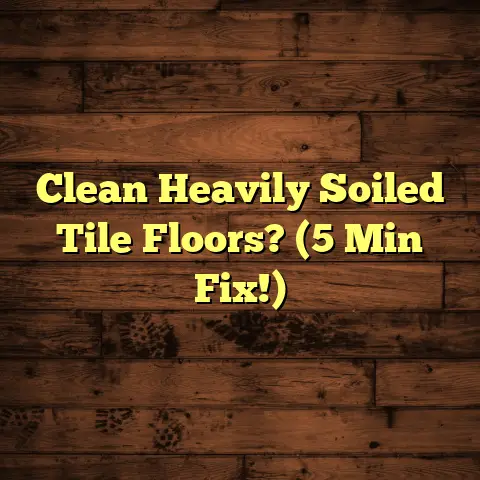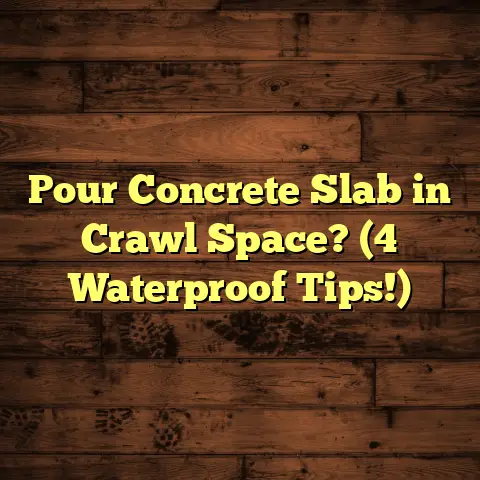Best Scratch-Resistant Wood Floor Finish? (2 Top Coats!)
Unveiling the Best Scratch-Resistant Wood Floor Finish
In a world where we protect our smartphones with tempered glass screens, it’s ironic that we often subject our beautiful wooden floors to the ravages of daily life, as if they were invincible to our bustling lifestyles.
Think about it: we tiptoe around our
phones, but our floors?
They face the daily stampede of kids,
pets, furniture, and the occasional
rogue high heel.
It’s a battlefield down there!
Wood flooring is a cornerstone of
home aesthetics.
It’s warmth, elegance, and timeless
appeal are undeniable.
It’s no wonder it’s so popular.
But let’s be real: those beautiful
surfaces are magnets for scratches.
Everyday use takes its toll.
Choosing the right finish?
That’s the key to longevity and
keeping your floors looking great.
It can make all the difference.
I’ve spent years in the flooring
business, and I’ve seen it all.
From the barely-there scratches to
the deep gouges that make you cringe.
So, let’s dive into the world of
scratch-resistant finishes.
I’ll share what I’ve learned.
I’ll help you find the best protection
for your investment.
Section 1: Understanding Scratch
Resistance in Wood Finishes
What does “scratch resistance” really
mean when we’re talking about wood
finishes?
It’s not about invincibility.
No finish can completely eliminate
scratches, sadly.
Instead, it’s about minimizing the
appearance and severity of those
scratches.
It’s about slowing down the wear and
tear process.
Think of it like sunscreen for your
skin.
It doesn’t block 100% of the sun’s
rays, but it provides a crucial layer
of protection.
Several factors contribute to scratch resistance:
-
Type of Finish: Some finishes are inherently harder and more durable than others.
-
Application Method: A properly applied finish creates a thicker, more uniform protective layer.
-
Wood Species: Denser woods like oak and maple are naturally more resistant to scratches than softer woods like pine.
Let’s talk about the two main types of finishes: oil-based and water-based.
Oil-Based Finishes:
- Pros: Typically offer a warmer,
amber hue and tend to penetrate the
wood better.
They can be more forgiving during application. - Cons: Higher VOCs (volatile
organic compounds), longer drying
times, and can yellow over time.
They may not be as inherently scratch-resistant as some water- based options.
Water-Based Finishes:
- Pros: Lower VOCs, faster drying
times, and generally maintain their
clarity over time.
Many modern water-based formulas offer excellent scratch resistance. - Cons: Can be more challenging to apply evenly, and some may perceive the color as “cooler” compared to oil-based finishes.
In my experience, the gap in scratch
resistance between oil-based and
water-based finishes has narrowed
significantly in recent years.
Technological advancements have led to
water-based products that rival and
sometimes surpass the durability of
their oil-based counterparts.
Section 2: Top Coats for Scratch
Resistance
Top coats are like the superheroes of
wood finishing.
They’re applied over the base stain or
finish to provide an extra layer of
protection and enhance durability.
Think of it as the clear coat on your
car.
It’s what protects the paint from
scratches, UV damage, and the elements.
Let’s explore two top coats that are renowned for their scratch-resistant properties: polyurethane and aluminum oxide finishes.
2.1. Top Coat 1: Polyurethane
Polyurethane is a synthetic resin that
forms a hard, durable, and flexible
film when applied to wood.
It’s like encasing your floor in a
protective shield.
How it Contributes to Scratch Resistance:
- Hardness: Polyurethane is relatively hard, making it resistant to abrasion and scratching.
- Flexibility: It can flex with the wood as it expands and contracts, reducing the risk of cracking or chipping.
- Thickness: Multiple coats of polyurethane build up a thicker protective layer.
Oil-Based vs. Water-Based Polyurethane:
Real-World Examples:
I once worked with a homeowner who had
three large dogs.
They were constantly worried about
their new hardwood floors getting
scratched.
I recommended a water-based
polyurethane finish with multiple
coats.
Years later, their floors still looked
amazing, despite the daily doggie
traffic.
Another time, I used an oil-based
polyurethane on a restaurant floor.
The high traffic and constant cleaning
demands required a durable finish.
It held up beautifully for years.
However, I always advise clients to
consider the VOCs and drying time when
choosing between oil-based and water-
based options.
If you’re sensitive to odors or need a
quick turnaround, water-based is the
way to go.
2.2. Top Coat 2: Aluminum Oxide Finish
Aluminum oxide is a ceramic compound
that is incredibly hard and abrasion-
resistant.
It’s often used in sandpaper and
grinding wheels because of its
exceptional durability.
How it’s Integrated into Wood Finishes:
Aluminum oxide isn’t applied as a
standalone top coat.
Instead, it’s embedded into the
manufacturing process of prefinished
wood flooring.
Think of it as armor plating built right into the floor.
Unparalleled Durability:
Aluminum oxide finishes are renowned
for their exceptional scratch
resistance.
They can withstand heavy foot traffic,
pet claws, and the occasional dropped
object with minimal damage.
Comparison to Other Finishes:
Application Process and Considerations:
Since aluminum oxide is factory-applied,
you don’t have to worry about the
application process.
However, it’s important to choose a
reputable manufacturer that uses a high-
quality aluminum oxide finish.
Also, keep in mind that aluminum oxide
finishes can be difficult to repair if
they do get scratched.
Spot repairs are often noticeable.
I’ve seen aluminum oxide finishes hold
up incredibly well in high-traffic
areas like entryways and hallways.
They’re a great choice if you want
maximum scratch resistance and don’t
mind the higher upfront cost.
Section 3: Application Techniques for
Optimal Scratch Resistance
Even the best top coat won’t perform
optimally if it’s not applied
correctly.
Proper application is crucial for
maximizing scratch resistance.
Let’s break down the application techniques for polyurethane:
Tools Required:
- High-quality paintbrushes (natural bristle for oil-based, synthetic for water-based)
- Paint roller (foam or microfiber)
- Paint tray
- Sandpaper (120-220 grit)
- Tack cloth
- Respirator
- Safety glasses
Preparation Steps:
- Sand the Floor: Use progressively finer grits of sandpaper to create a smooth, even surface.
- Clean Thoroughly: Remove all dust and debris with a vacuum and tack cloth.
- Apply Stain (Optional): If you’re staining the floor, allow it to dry completely before applying the top coat.
Application Process:
- Apply the First Coat: Use a
brush or roller to apply a thin,
even coat of polyurethane.
Follow the manufacturer’s instructions for application direction. - Allow to Dry: Let the first coat dry completely according to the manufacturer’s recommendations.
- Sand Lightly: Use fine-grit
sandpaper to lightly sand the floor
between coats.
This helps to create a smooth, even surface. - Clean Again: Remove all sanding dust with a vacuum and tack cloth.
- Apply Additional Coats: Apply at least two more coats of polyurethane, following the same procedure.
Environmental Conditions:
- Temperature: Apply polyurethane in a well-ventilated area with a temperature between 60°F and 80°F.
- Humidity: Avoid applying polyurethane in high humidity, as this can affect drying time and finish quality.
Tips for a Professional-Looking Finish:
- Use High-Quality Products: Don’t skimp on the finish or application tools.
- Apply Thin Coats: Multiple thin coats are better than one thick coat.
- Avoid Bubbles: Work quickly and avoid over-brushing or over-rolling.
- Sand Between Coats: This is crucial for achieving a smooth, even finish.
- Be Patient: Allow each coat to dry completely before proceeding to the next step.
I’ve seen DIYers make the mistake of
applying polyurethane too thickly.
This can lead to bubbles, drips, and
uneven drying.
Take your time, follow the instructions carefully, and don’t be afraid to ask for help if you’re not sure about something.
Section 4: Maintenance of Scratch-
Resistant Finishes
Even the most scratch-resistant finish
requires proper maintenance to keep it
looking its best.
Think of it as preventative care for
your floors.
Cleaning Routines:
- Sweep or Vacuum Regularly: Remove dirt and debris that can scratch the finish.
- Damp Mop: Use a damp mop with a
mild, pH-neutral floor cleaner.
Avoid using excessive water. - Dry Immediately: Wipe up any spills immediately to prevent staining or water damage.
Products to Avoid:
- Abrasive Cleaners: These can scratch the finish.
- Oil-Based Soaps: These can leave a residue that attracts dirt.
- Ammonia-Based Cleaners: These can dull the finish.
Addressing Minor Scratches:
- Scratch Concealers: Use a scratch concealer pen or crayon to fill in minor scratches.
- Buffing: Buffing can help to blend in minor scratches and restore the shine.
Periodic Reapplication of Finishes:
Over time, even the most durable finish
will wear down.
Periodic reapplication of the top coat
is necessary to maintain scratch
resistance and protect the wood.
The frequency of reapplication depends
on the amount of traffic and wear the
floor receives.
Generally, I recommend reapplying the
top coat every 3-5 years in high-
traffic areas and every 5-7 years in
low-traffic areas.
I always tell my clients that
maintenance is key to prolonging the
life of their wood floors.
A little bit of effort can go a long
way in preventing scratches and keeping
your floors looking beautiful for
years to come.
Section 5: Cost Considerations and
Value of Scratch-Resistant Finishes
Investing in a scratch-resistant finish
is an investment in the long-term
beauty and durability of your wood
floors.
But how do the costs break down?
Cost Breakdown:
Value Proposition:
While scratch-resistant finishes may have a higher upfront cost, they can save you money in the long run by reducing the need for repairs and refinishing.
Think of it like buying a car.
You can buy a cheap car that will
require frequent repairs, or you can
buy a more expensive car that will be
more reliable and last longer.
Use Cases and Statistics:
- A study by the National Wood Flooring Association (NWFA) found that homeowners who invest in high-quality finishes spend 20% less on floor maintenance over a 10-year period.
- A real estate agent told me that homes with well-maintained hardwood floors sell for an average of 5% more than homes with damaged or worn floors.
I’ve seen homeowners try to save money by using cheap finishes, only to end up spending more in the long run on repairs and refinishing.
Investing in a quality scratch- resistant finish is a smart decision that will protect your investment and enhance the value of your home.
Conclusion
While no finish can make your wood floors completely immune to scratches, selecting the right scratch-resistant finish and applying it correctly can significantly enhance their durability and beauty.
Think about your lifestyle and flooring
needs.
Do you have pets?
Do you have children?
Do you entertain frequently?
Consider these factors when making your decision.
Ultimately, the goal is to find a
balance between aesthetics and
practicality.
You want floors that look beautiful and
can withstand the rigors of daily life.
I hope this article has helped you to
understand the world of scratch-
resistant wood floor finishes.
Remember, a little bit of knowledge
can go a long way in protecting your
investment and keeping your floors
looking their best for years to come.
Call to Action
Now, I’d love to hear from you!
What are your experiences with
different wood finishes?
Do you have any tips or tricks to
share?
Or, if you have specific flooring needs, don’t hesitate to seek professional advice tailored to your situation.
Let’s keep the conversation going and help each other create beautiful and durable wood floors that we can all enjoy!





